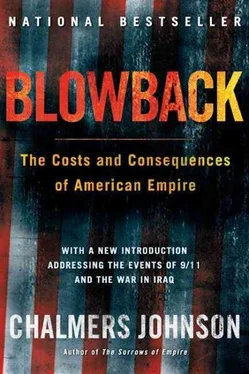Chalmers Johnson - Blowback, Second Edition - The Costs and Consequences of American Empire
Здесь есть возможность читать онлайн «Chalmers Johnson - Blowback, Second Edition - The Costs and Consequences of American Empire» весь текст электронной книги совершенно бесплатно (целиком полную версию без сокращений). В некоторых случаях можно слушать аудио, скачать через торрент в формате fb2 и присутствует краткое содержание. Год выпуска: 0101, ISBN: 0101, Издательство: Macmillan, Жанр: Старинная литература, на английском языке. Описание произведения, (предисловие) а так же отзывы посетителей доступны на портале библиотеки ЛибКат.
- Название:Blowback, Second Edition: The Costs and Consequences of American Empire
- Автор:
- Издательство:Macmillan
- Жанр:
- Год:0101
- ISBN:9780805075595
- Рейтинг книги:5 / 5. Голосов: 1
-
Избранное:Добавить в избранное
- Отзывы:
-
Ваша оценка:
- 100
- 1
- 2
- 3
- 4
- 5
Blowback, Second Edition: The Costs and Consequences of American Empire: краткое содержание, описание и аннотация
Предлагаем к чтению аннотацию, описание, краткое содержание или предисловие (зависит от того, что написал сам автор книги «Blowback, Second Edition: The Costs and Consequences of American Empire»). Если вы не нашли необходимую информацию о книге — напишите в комментариях, мы постараемся отыскать её.
Blowback, Second Edition: The Costs and Consequences of American Empire — читать онлайн бесплатно полную книгу (весь текст) целиком
Ниже представлен текст книги, разбитый по страницам. Система сохранения места последней прочитанной страницы, позволяет с удобством читать онлайн бесплатно книгу «Blowback, Second Edition: The Costs and Consequences of American Empire», без необходимости каждый раз заново искать на чём Вы остановились. Поставьте закладку, и сможете в любой момент перейти на страницу, на которой закончили чтение.
Интервал:
Закладка:
By the end of the 1980s, China had begun seriously to incorporate the lessons of high-speed economic growth pioneered in Americandominated East Asia. Its still ruling Communist Party also began tacitly to stress nationalism rather than communism, which was then collapsing in Russia, to garner political support. On the basis of this new nationalism, China began to reach out and accept investment and other forms of assistance from the fifty-five million overseas Chinese, particularly those living in Hong Kong and Southeast Asia. It also slowly opened the country to foreign trade and investment with capitalist countries, so long as the terms were mutually beneficial. This strategy held the possibility of ultimately delivering on the second goal of the Chinese revolution—namely, the creation of a per capita income approaching that of the other major powers. Since China is by far the world’s largest society in terms of population, if it succeeds it may also become the world’s most powerful nation.
China’s attempt to emulate the economies of Japan, South Korea, Taiwan, and Singapore is, however, fraught with difficulties, above all how to control the increasing gap between rich and poor in a previously Communist country. In terms of relations with the rest of the world, China’s products will never enjoy the virtually unrestricted access to the American market and its sources of technology that Japan and others enjoyed in exchange for their support during the Cold War. This was made clear during 1999 when the United States was caught up in a politically driven panic over allegations of Chinese industrial espionage and imports of technologically advanced equipment for purposes of reverse engineering. On the other hand, China has one major asset not available to most developing nations: the overseas Chinese. This reservoir of talent, capital, and experience is open to a China that stresses nationalism rather than communism. China has so far been very cautious in lifting currency controls and import barriers that protect it from the full pressures and volatility of the international market, a precaution that served it well during the East Asian financial crisis of 1997 and after. China has no choice but to continue to open up to international trade; its development strategy will not work if, as in the Maoist days, it once again isolates itself from the rest of the world. At least for now, however, the news from China is reasonably positive. The peaceful reversion of Hong Kong to mainland rule in 1997 and its maintenance as a global financial center were a clear sign of China’s determination and its capacity to succeed economically.
Throughout much of recorded history China was the world’s largest economy. Today, as it reemerges on the world scene, the World Bank estimates that it has already passed Germany to become the world’s third-largest economy, after the United States and Japan, as well as the fastest-growing economy. The Chinese State Statistical Bureau has calculated that during 1995 it grew by some 10.2 percent, down from the 11.8 percent increase of 1994 but still above the government’s target growth rate of between 9 percent and 10 percent. The global economic crisis that began in 1997 has slowed but certainly not stopped growth. Even if in the future China grows at only 7 percent a year, it will surpass a U.S. economy growing at a 3 percent rate sometime between 2020 and 2030. Needless to say, extending present trends statistically into the future is a deeply perilous activity. It is perfectly possible that environmental degradation, or natural disasters, or a downward spiral into depression and poverty due to fast and messy industrial modernization will cause pressures of a sort we cannot even imagine today and sooner than we think. But thus far, China has a better development strategy than any it has experimented with since 1949.
Since economic reform began in 1978, China’s annual average per capita income has risen 6.7 times but still remains unimaginably small: $464 in China’s cities and $186.75 in rural areas, according to 1995 official estimates (but perhaps as much as $2,000 per capita in terms of purchasing power, given the low prices of basic human necessities). By contrast, Japan’s per capita income in 1993 was $31,450 and that of the United States $24,750. China’s labor costs are still just 10 to 15 percent of those in Hong Kong, Taiwan, and South Korea but on a par with those in India.
The Chinese Communist Party, the world’s largest political organization, no longer has much legitimacy in the eyes of the Chinese people. Although it came to power in 1949 as the leader of the largest and most complex revolution of all, it squandered its great popularity: in rural China because of the famine that followed the Great Leap Forward; among hard-core Communist revolutionaries because of the Cultural Revolution; and, finally, among urban intellectuals and a burgeoning middle class because of the repression at Tiananmen Square in 1989 and the nearly simultaneous collapse of communism in Europe.
The Chinese Communist Party continues to rule through a combination of inertia, improving economic conditions, favorable comparisons with the past, nationalism, and a complex set of inducements and penalties. There is every reason to believe that it will be able to do so for the foreseeable future, despite occasional periods of instability. Taiwan, whose government comes from a similar background (single-party rule by Sun Yat-sen’s political party, the Kuomintang, which Chiang Kaishek inherited), offers strong evidence that the mainland could also slowly evolve into a prosperous, relatively open society. Pressure for democratization will probably become a serious internal issue, if it ever does, only around the year 2010, when some 30 percent of the mainland population might have reached a per capita income of about $4,000. Until then, the bulk of the Chinese population will probably remain content with economic progress, better health care, and other practical concerns.
From the Politburo down, most Chinese now believe in pursuing economic reforms, even if different groups support the reform process for different reasons. There is also something of a consensus on the necessity of maintaining a powerful, independent political authority to implement such reforms. The Chinese leaders are firmly convinced that authoritarian rule is indispensable to the success of their market-driven policies, and there is evidence that the Chinese population accepts this view because of the economic achievements of recent years. In this view, without authoritarian political control, economic reform will rapidly breed new economic interests and corruption, already a serious problem. Long-term success requires some authority capable of occasionally cracking down on corruption, complete with public executions as warnings to others. The more corrupt interests become entrenched, the more resentment against them is likely to generate a cycle of political protest, followed by economic instability. Always before the Chinese leadership is the example of the virtual collapse of the former Soviet Union and the resulting impoverishment of large sectors of the Russian population when authoritarianism was allowed to lapse and the economy was “reformed” in accordance with the theories of American economists.
In general terms, the greatest weakness of the development-state strategy is that it both causes and can be crippled by domestic political turmoil. In the other East Asian economic success stories, turmoil has been kept in check by authoritarian political systems of various sorts, the reasonably equitable distribution of incomes, and the promotion of distinctive “Asian values” focused on condemning the alleged selfishness of Western individualism and sometimes of Western democratic institutions as well. Asian leaders have often argued that democracy undercuts development. Lee Kuan Yew, the legendary first prime minister of the rich city-state of Singapore and a persistent critic of U.S. foreign policy in Southeast Asia, is the most articulate exponent of this view. As Lee has put it, “With few exceptions, democracy has not brought good government to new developing countries. Democracy has not led to development because the governments did not establish [the] stability and discipline necessary for development.” 5It should be noted that in the 1990s, Singapore, which may not be as pleasant a place for an individualist to live, nonetheless has had a higher per capita income ($23,565) than Australia ($19,960), something that lends a certain credibility in Asian eyes to what its leader has had to say.
Читать дальшеИнтервал:
Закладка:
Похожие книги на «Blowback, Second Edition: The Costs and Consequences of American Empire»
Представляем Вашему вниманию похожие книги на «Blowback, Second Edition: The Costs and Consequences of American Empire» списком для выбора. Мы отобрали схожую по названию и смыслу литературу в надежде предоставить читателям больше вариантов отыскать новые, интересные, ещё непрочитанные произведения.
Обсуждение, отзывы о книге «Blowback, Second Edition: The Costs and Consequences of American Empire» и просто собственные мнения читателей. Оставьте ваши комментарии, напишите, что Вы думаете о произведении, его смысле или главных героях. Укажите что конкретно понравилось, а что нет, и почему Вы так считаете.










